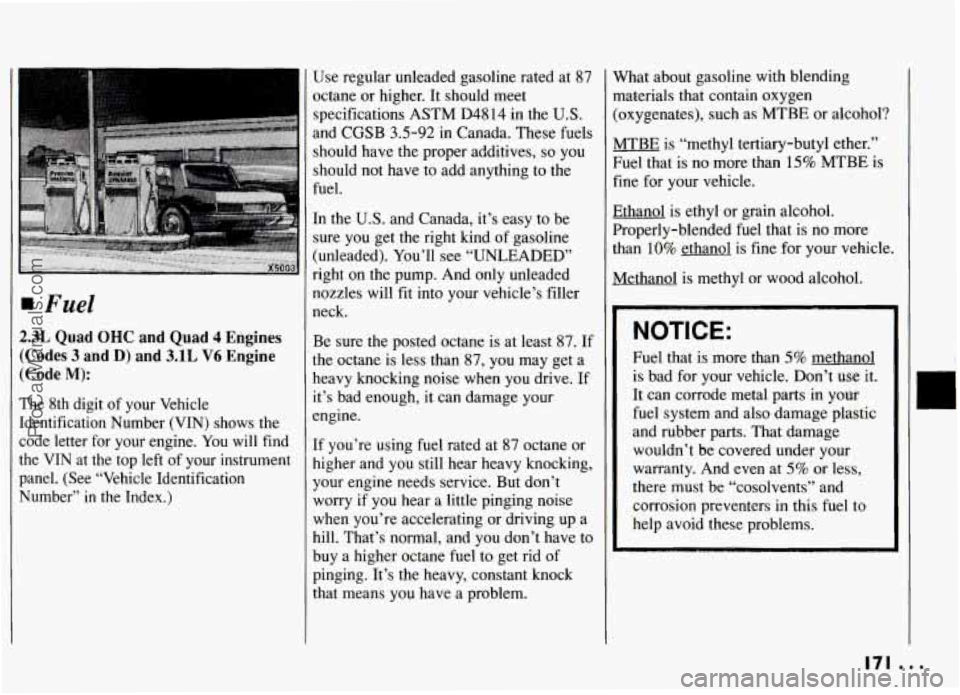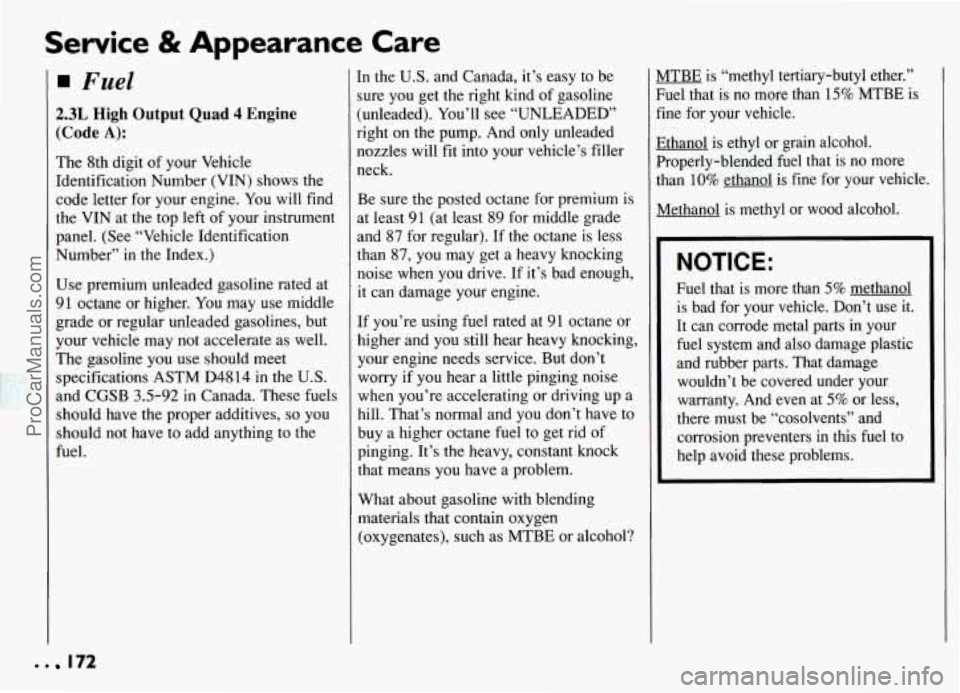1994 PONTIAC GRAND-AM fuel additives
[x] Cancel search: fuel additivesPage 172 of 274

I Fuel
!.3L Quad OHC and Quad 4 Engines
Codes
3 and D) and 3.1L V6 Engine
Code
M):
’he 8th digit of your Vehicle
dentification Number (VIN) shows the
:ode letter for your engine. You will find
he VIN at the top left of your instrument
)anel. (See “Vehicle Identification
Vumber”
in the Index.)
Use regular unleaded gasoline rated at 87
octane or higher. It should meet
specifications ASTM D4814 in the
U.S.
and CGSB 3.5-92 in Canada. These fuels
should have the proper additives,
so you
should not have to add anything
to the
fuel.
In the U.S. and Canada, it’s easy to be
sure you get
the right kind of gasoline
(unleaded). You’ll see “UNLEADED’
right on the pump. And only unleaded
nozzles will fit into your vehicle’s filler
neck.
Be sure the posted octane is at least 87. If
the octane is less than
87, you may get a
heavy knocking noise when you drive.
If
it’s bad enough,-it can damage your
engine.
If you’re using fuel rated at 87 octane or
higher and
you still hear heavy knoclung,
your engine needs service. But don’t
worry
if you hear a little pinging noise
when you’re accelerating or driving up a
hill. That’s normal, and you don’t have to
buy a higher octane fuel
to get rid of
pinging. It’s the heavy, constant knock
that means you have a problem.
What about gasoline with blending
materials that contain oxygen
(oxygenates), such as MTBE or alcohol?
MTBE is “methyl tertiary-butyl ether.’’
Fuel that
is no more’than 15% MTBE is
fine for your vehicle.
Ethanol is ethyl or grain alcohol.
Properly-blended fuel that is no more
than
10% ethanol is fine for your vehicle.
Methanol is methyl or wood alcohol.
NOTICE:
Fuel that is more than 5% methanol
is bad for your vehicle. Don’t
use it.
It can corrode metal. parts in yohs
fuel system and also, damage plastic
and rubber parts. That damage
wouldn’t be covered under your
warranty. And even at
5% or less,
there must be “cosolvents” and
corrosion preventers in
this fuel to
help avoid these problems.
171 ...
ProCarManuals.com
Page 173 of 274

Service & Appearance Care
Fuel
2.3L High Output Quad 4 Engine
(Code A):
The 8th digit of your Vehicle
Identification Number (VIN) shows the
code letter for your engine. You will find
the VIN at the top left of your instrument
panel. (See “Vehicle Identification
Number” in the Index.)
Use premium unleaded gasoline rated at
91 octane
or higher. You may use middle
grade or regular unleaded gasolines, but
your vehicle may not accelerate as well.
The gasoline you use should meet
specifications ASTM D4814 in the
U.S.
and CGSB 3.5-92 in Canada. These fuels
should have the proper additives,
so you
should not have to add anything to the
fuel.
In the U.S. and Canada, it’s easy to be
sure you get the right kind of gasoline
(unleaded). You’ll see “UNLEADED’
right on the pump. And only unleaded
nozzles will fit into your vehicle’s filler
neck.
Be sure the posted octane for premium is
at least 91 (at least 89 for middle grade
and
87 for regular). If the octane is less
than
87, you may get a heavy knocking
noise when you drive. If it’s bad enough,
it can damage your engine.
If you’re using fuel rated at 91 octane or
higher and you still hear heavy knocking,
your engine needs service. But don’t
worry
if you hear a little pinging noise
when you’re accelerating or driving up a
hill. That’s normal and you don’t have to
buy a higher octane fuel to get rid of
pinging. It’s the heavy, constant knock
that means you have a problem.
What about gasoline with blending
materials that contain oxygen
(oxygenates), such as MTBE or alcohol?
MTBE is “methyl tertiary-butyl ether.’’
Fuel that
is no more than 15% MTBE is
Fine for your vehicle.
Ethanol is ethyl or grain alcohol.
Properly-blended fuel that is no more
than
10% ethanol is fine for your vehicle.
Methanol is methyl or wood alcohol.
NOTICE:
Fuel that is more than 5% methanol
is bad for your vehicle. Don’t use it.
It can corrode metal parts in your
fuel system and also damage plastic
and rubber parts. That damage
wouldn’t be covered under your
warranty. And even at
5% or less,
there must be “cosolvents” and
corrosion preventers in this fuel
to
help avoid these problems.
. . 172
ProCarManuals.com
Page 174 of 274

Gasolines for Cleaner Air
Your use of gasoline with deposit control
additives will help prevent deposits from
forming in your engine and fuel system.
That helps keep your engine in tune and
your emission control system working
properly. It’s good for your vehicle, and
you’ll be doing your part for cleaner air.
Many gasolines are now blended with
oxygenates. General Motors recommends
that you use gasolines with these blending
materials, such as MTBE and ethanol. By
doing
so, you can help clean the air,
especially in those parts of the country
that have high carbon monoxide levels.
[n addition, some gasoline suppliers are
now producing reformulated gasolines.
These gasolines are specially designed to
reduce vehicle emissions. General Motors
recommends that you use reformulated
gasoline. By doing
so, you can help clean
the air, especially in those parts of the
zountry that have high ozone levels.
You should ask your service station
lperators
if their gasolines contain deposit
zontrol additives and oxygenates, and if
:hey have been reformulated to reduce
fehicle emissions.
Fuels in Foreign
Countries
If you plan on driving in another country
outside the
U.S. or Canada, unleaded fuel
may be hard to find. Do not use leaded
gasoline. If you use even one tankful,
your emission controls won’t work well
or at all. With continuous use, spark plugs
can get fouled, the exhaust system can
corrode, and your engine oil can
deteriorate quickly. Your vehicle’s oxygen
sensor will be damaged. All of that means
costly repairs that wouldn’t be covered by
your warranty.
To check on fuel availability, ask an auto
club, or contact a major oil company that
does business in the country where you’ll
be driving.
You can also write us at the following
address for advice. Just tell
us where
you’re going and give your Vehicle
Identification Number
(VIN).
General Motors Overseas Distribution
Corporation,
North American Export Sales (NAES)
1908 Colonel Sam Drive
Oshawa, Ontario
L 1 H 8P7
173...
ProCarManuals.com
Page 266 of 274

Highway Hypnosis ........... 134
.Hill and Mountain ............ 134
In a Foreign Country
.......... 172
In the Rain
.................. 13C
Logg Distance ............... 132
Loss of Control
.............. 128
On Curves
.................. 125
Passing
.................... 127
Skidding
................... 128
Through Deep Standing Water
... 58
Winter Driving .............. 136
With a Trailer
............... 144
Driving.on Snow or Ice .......... 136
Drunken Driving
............... 120
Easy-Entry Seat ................ 11
Electrical Equipment. Adding
. 107. 2 1 1
Emergencies. Braking .. .. ........ 125
Emergencies on the Road
......... 147
Emergencies. Steering
in ......... 126
Emergency Starting
.. i .......... 148
Emergency Towing
............. 152
Engine Coolant Heater (Engine Block Heater)
....... : ..... 58. 182
Engine Coolant Temperature
Warning Light ................. 94
Engine Identification
............ 2 11
Engine Oil
.................... 179
Additives ................... 182
Checking
& Adding .......... 179
Disposing of Used Oil
........ 182
Engine Coolant (see “Coolant”) .... 188
Energy Conserving ........... 18 I
Filter .................. 182. 22C
Kind of Oil to Use
............ 18C
Pressure- Gage ................ 9f
Warning Light
................ 95
When to Change ............. 182
Engine Overheating ............. 156
Engine Specifications
............ 2 19
Engine. Starting
................. 56
Automatic Transaxle ........... 56
Manual Transaxle ............. 56
2.3L Quad 4 Engine
........... 56
3.lL V6 Engine ............... 57
Ethanol in Gasoline ......... 17 1. 172
Exhaust
Dangerous Gas in
......... 70. 138
Pirking with the Engine
Running ................ 67. 69
Expectant Mothers. Use of Safety
Belts ......................... 26
Expressway Driving
............. 132
Extender. Safety Belt
............. 42
Exterior Appearance (see “Appearance
Care”) ....................... 204
Fabric Cleaning (see “Appearance
Care”) ...................... 204
Filling the Fuel Tank
........ 174. 2 16
Filter. Oil
................ 182. 220
Finish Damage
................. 209
Flashers. Hazard Warning
........ 148
Flat Tire
...................... 161
Flooded Engine ................. 57
Flow-Through Ventilation System . . 105
Fluid
‘Brake ...................... 192
Capacities
.................. 215
Hydraulic Clutch
............. 187
Power Steering
.......... 190. 216
Transaxle
Automatic ........... 184. 215
Manual
.............. 186. 215
Windshield Washer
........... 191
Fluids
& Lubricants ............. 238
Fog Lights
................. 79. 196
Freeway Driving
............... 132
French Language Manual
.......... 2
Fuel
......................... 171
Alcohol
in Fuel .......... 17 1. 172
Capacity
................... 216
Exhaust Warnings
......... ..70. 138
Filling Your Tank
......... 1 .. 174
Fuels
with Alcohol ....... !7 1. 172
Gage
........................ 93
In Foreign Countries .......... 173
Remote Fuel Filler Door
........ 53
Requirements
............... 171
Fuse Usage Chart ............... 213
Fuses
& Circuit Breakers ......... 212
Gages
Coolant Temperature .......... 94
Fuel ........................ 93
Oil Pressure .................. 96
265
E
ProCarManuals.com